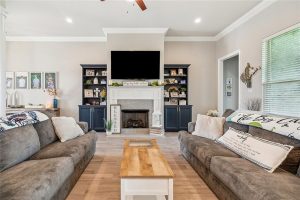With sweat dripping down his face, Ashley Van der Meulen carefully navigated the sweltering attic of a home in Metairie, methodically inspecting the roof and structure. His goal? To answer critical questions that could help save the homeowner thousands of dollars on insurance: What type of nails are securing the roof? How far apart are they? Is there a secondary moisture barrier?
Van der Meulen is one of about two dozen state-licensed surveyors in Louisiana conducting wind mitigation inspections. This service, which costs around $300 and takes about an hour, has proven to be a valuable tool for homeowners looking to lower their insurance premiums by identifying construction features that reduce windstorm damage. Once the inspection is complete, homeowners can submit the survey results to their insurance company for potential discounts.
“The insurance company has never seen your house,” explains Andrew “Trey” Pellegrin, a surveyor with Southern Wind Mitigation. “They assume it’s built with weak materials. We show them it’s built to a higher standard.”
Wind mitigation inspections gained attention in Louisiana after Hurricane Katrina. In the aftermath, the state legislature passed a law requiring insurers to offer discounts to homeowners who upgraded their properties to better withstand hurricanes. Despite this, the program remained relatively unknown until recently, as rising insurance rates have renewed interest.
The Home Builders Association of Greater New Orleans is one of the organizations encouraging homeowners to take advantage of these inspections. Dan Mills, the association’s CEO, saw firsthand how valuable the service can be when his wind mitigation inspection saved him $1,600 on his $8,000 Louisiana Citizens policy for his Tall Timbers home.
“The value of wind mitigation is undeniable,” Mills says. “I recommend every homeowner get one.”
However, the discounts can vary widely depending on the insurance company, making savings unpredictable. For example, Jefferson Parish Council member Jennifer Van Vrancken found that her insurer had already applied some discounts, but she was unable to get clear information on what exactly was credited.
Surveyors like Pellegrin wish insurers were more transparent about the discounts they offer. The standard inspection form contains 13 questions tied to potential discounts, but some insurers, such as Louisiana Citizens, only offer discounts for specific measures. Pellegrin noted that USAA tends to provide the best discounts, though even he wishes for a “cheat sheet” outlining which insurers offer what discounts.
For homes that don’t qualify for a fortified designation—an advanced certification requiring a more thorough inspection—wind mitigation discounts can still yield significant savings. Take Patty Willhite’s Uptown New Orleans home, for example. After installing a new roof and submitting her wind mitigation form, she saved $1,000 on her $7,000 insurance policy, even though her home’s rafters didn’t meet the stricter requirements for a fortified roof.
In another Metairie home, Van der Meulen continued his inspection, this time examining windows as homeowner Gavin Langston observed. Langston, an employee at Fidelity Bank, had been recommending wind mitigation inspections to clients dealing with rising insurance premiums. When his own insurance costs shot up by 34%, he decided to try the inspection himself.
Even if homeowners don’t immediately qualify for discounts, these inspections—valid for up to five years—can still provide valuable insights into potential home improvements. “It gives homeowners a clear picture of what they need to do to reduce risk and potentially earn discounts in the future,” says Chip Fornaris, a surveyor with J Monroe Home Inspections.
To encourage more homeowners to take advantage of wind mitigation inspections, the Home Builders Association has formed a task force focused on increasing the number of available inspectors and improving the standard inspection form. Mills hopes that in the short term, these efforts will offer financial relief to homeowners. In the long term, he believes that improving the resilience of the housing stock could encourage more insurers to return to Louisiana.
As insurance rates continue to climb, wind mitigation inspections are emerging as an essential tool for homeowners looking to protect both their homes and their wallets.

